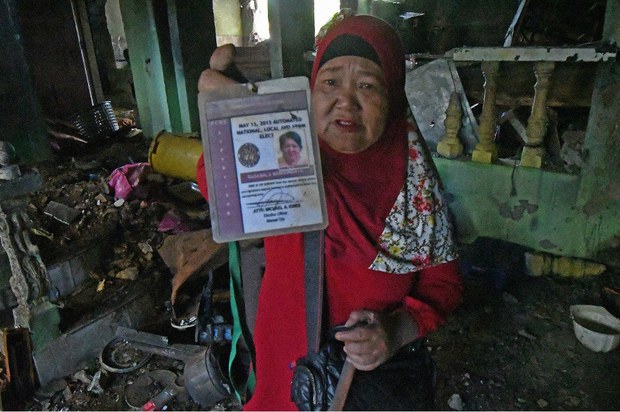Pain, Despair Greet Returning Evacuees in Philippines’ Marawi
2018.04.06
Marawi, Philippines
 Rasamala Magondaraya, 62, shows her identification card, the only personal possession she retrieved from her ruined house in the destroyed southern Philippine city of Marawi, April 6, 2018.
Rasamala Magondaraya, 62, shows her identification card, the only personal possession she retrieved from her ruined house in the destroyed southern Philippine city of Marawi, April 6, 2018.
When Rasamala Magondaraya entered the ruins of her home in the southern Philippine city of Marawi, she could not recognize anything but the spray-painted graffiti on what remained of the walls: ISIS.
The bold acronym spelled the other name for the Islamic State (IS), whose followers attacked Marawi in May 2017 and engaged security forces in five months of vicious gun battles that killed more than 1,200, most of them militants.
Magondaraya, 62, was appalled as she and her children stared at the holes in the wall and a huge pit dug in what used to be the living room where she and her family gathered in happier times.
Entire sections of their four-story home had collapsed under heavy bombardment.
“This is what I found. The only thing that was left,” Magondaraya, 62, said, holding up an identification card she found in the rubble.
“At least I have some identity left,” she said, choking back tears.
Her children fared no better, retrieving just a few pieces of clothing they were able to salvage.
Two blocks away, Samia Macondara, 35, had a similar reaction when she saw what remained of her bakery and small grocery store – a pile of concrete and twisted steel.
Macondara said when she escaped as Marawi descended into chaos, she hid a small fortune inside a vault.
On Thursday, Macondara and her brother, Abdul, rummaged through the clutter of what they believed was where they had placed the steel box, but found no traces of it.
Since they fled Marawi, Macondara said she lived as a refugee and had depended on food aid given by government agencies.
She has since left the evacuation camp in Balo-i, a small town about 32 km (20 miles) from Marawi, and transferred to a relative’s farm in a nearby village.
“We have been subsisting on root crops since then,” said Macondara, a mother of two. “At least we have that, but I want to have my business back again.”
![180406-PH-marawi-inside-1.jpg An aerial photograph shows the devastated areas of the southern Philippine city of Marawi, April 6, 2018. [Richel V. Umel/BenarNews]](/english/news/philippine/marawi-return-04062018145626.html/180406-PH-marawi-inside-1.jpg/@@images/e8f386d9-e1b3-41d2-a093-c1621b1bbc70.jpeg)
Unexploded ordnance
Task Force Bangon Marawi, the agency that oversees the return of evacuees, allowed about 1,200 residents to visit their homes inside the main affected area.
Since April 1, the Philippine government told residents they could venture back and retrieve whatever possessions they could find from their homes. They were herded out of the city by sunset of the same day.
A sign hanging on a tree warned residents to be careful in combing through the ruins, where unexploded ordnance lay unrecovered.
Col. Romeo Brawner Jr., local army deputy commander, said the military could not provide an estimate on the number of explosives that litter the debris.
Among the deadliest ordnance are the 500-pound “general purpose” bombs dropped by the Philippine Air Force FA50 jets at the height of the fighting to allow the military to flush out the enemy fighters hiding in buildings. Seventeen of these bombs did not explode and pose a danger to the returning civilians, Brawner said.
“Army ordnance disposal team found only nine of the bombs. There are still eight bombs out there,” he said.
So far, the military has recovered 1,178 unexploded bombs and 323 improvised explosives since fighting ended.
Felix Castro, head of the task force overseeing the return of the thousands of refugees, said the visits in the 24 villages of the main affected areas would continue until May.
Residents would not be allowed to rebuild their houses until the area is cleared of debris and ruined buildings, Castro said.
A business consortium of Chinese and Filipino firms will lead the construction of the 250-hectare affected area, he said without providing details.
Five-month battle
Fighting began in May 2017 when government troops moved to arrest Isnilon Hapilon, the leader of the IS in the country. But the soldiers were repulsed by a huge militant force that included foreign fighters from Southeast Asia and the Middle East.
President Rodrigo Duterte had admitted he underestimated the enemy strength, and enlisted the help of the U.S. and Australian governments, which provided crucial intelligence help.
In October, Hapilon was declared killed, ending the fighting.
But almost a year after the gun battles started, Marawi remains largely deserted and devoid of any visible commercial activity.
Most of its 200,000 residents have not been allowed to return home permanently.
![180406-PH-marawi-inside-2.jpg Soldiers watch as residents return to their ruined homes in southern Philippine city of Marawi, April 4, 2018. [Richel V. Umel/BenarNews]](/english/news/philippine/marawi-return-04062018145626.html/180406-PH-marawi-inside-2.jpg/@@images/95a08fc0-497e-4fbf-b47e-e956f5c2f26d.jpeg)







